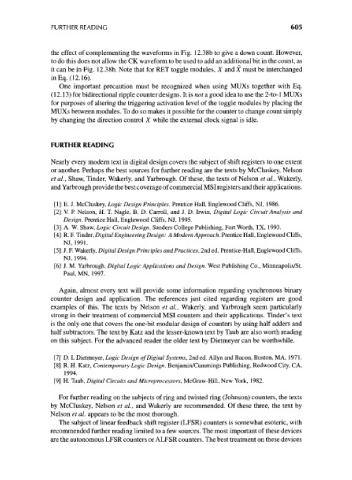Page 635 - Engineering Digital Design
P. 635
FURTHER READING 605
the effect of complementing the waveforms in Fig. 12.38b to give a down count. However,
to do this does not allow the CK waveform to be used to add an additional bit in the count, as
it can be in Fig. 12.38b. Note that for RET toggle modules, X and X must be interchanged
in Eq. (12.16).
One important precaution must be recognized when using MUXs together with Eq.
(12.13) for bidirectional ripple counter designs. It is not a good idea to use the 2-to-l MUXs
for purposes of altering the triggering activation level of the toggle modules by placing the
MUXs between modules. To do so makes it possible for the counter to change count simply
by changing the direction control X while the external clock signal is idle.
FURTHER READING
Nearly every modern text in digital design covers the subject of shift registers to one extent
or another. Perhaps the best sources for further reading are the texts by McCluskey, Nelson
et al., Shaw, Tinder, Wakerly, and Yarbrough. Of these, the texts of Nelson et al, Wakerly,
and Yarbrough provide the best coverage of commercial MSI registers and their applications.
[1] E. J. McCluskey, Logic Design Principles. Prentice Hall, Englewood Cliffs, NJ, 1986.
[2] V. P. Nelson, H. T. Nagle, B. D. Carroll, and J. D. Irwin, Digital Logic Circuit Analysis and
Design. Prentice Hall, Englewood Cliffs, NJ, 1995.
[3] A. W. Shaw, Logic Circuit Design. Sanders College Publishing, Fort Worth, TX, 1993.
[4] R. F. Tinder, Digital Engineering Design: A Modern Approach. Prentice Hall, Englewood Cliffs,
NJ, 1991.
[5] J. F. Wakerly, Digital Design Principles and Practices, 2nd ed. Prentice-Hall, Englewood Cliffs,
NJ, 1994.
[6] J. M. Yarbrough, Digital Logic Applications and Design. West Publishing Co., Minneapolis/St.
Paul, MN, 1997.
Again, almost every text will provide some information regarding synchronous binary
counter design and application. The references just cited regarding registers are good
examples of this. The texts by Nelson et al., Wakerly, and Yarbrough seem particularly
strong in their treatment of commercial MSI counters and their applications. Tinder's text
is the only one that covers the one-bit modular design of counters by using half adders and
half subtracters. The text by Katz and the lesser-known text by Taub are also worth reading
on this subject. For the advanced reader the older text by Dietmeyer can be worthwhile.
[7] D. L Dietmeyer, Logic Design of Digital Systems, 2nd ed. Allyn and Bacon, Boston, MA, 1971.
[8] R. H. Katz, Contemporary Logic Design. Benjamin/Cummings Publishing, Redwood City, CA,
1994.
[9] H. Taub, Digital Circuits and Microprocessors, McGraw-Hill, New York, 1982.
For further reading on the subjects of ring and twisted ring (Johnson) counters, the texts
by McCluskey, Nelson et al., and Wakerly are recommended. Of these three, the text by
Nelson et al. appears to be the most thorough.
The subject of linear feedback shift register (LFSR) counters is somewhat esoteric, with
recommended further reading limited to a few sources. The most important of these devices
are the autonomous LFSR counters or ALFSR counters. The best treatment on these devices

